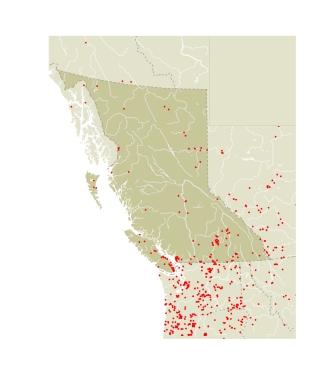Painted Ladies are strongly migratory, with permanent populations breeding year-round in the deserts of the southern USA and northern Mexico. In spring they migrate north, with the migrants estimated as several billion individuals in some years. Only a tiny proportion of the migrants reach BC, hence none are seen in some years and thousands are seen in other years. Apparently only one generation of offspring is produced in BC, with the first adults emerging in July. They do not appear to hibernate as adults or larvae, so BC must be recolonized by migrants each summer. Hardy (1953, 19S9b) summarizes some of the "migration years" of that time on Vancouver Island and other areas of BC. Painted Ladies appear to hibernate successfully in Colorado (Scott 1992), and one early March record in BC indicates successful hibernation. There is currently no evidence that Painted Ladies migrate south from BC in the fall. There are sporadic reports of southward migrations elsewhere, such as in northern California (Shapiro 1980b). Populations in France and North America are genetically very similar (Shapiro and Geiger 1989), suggesting that some migration across the Atlantic may occur.
Larval foodplants recorded outside BC are in many different plant families, but members of the Asteraceae, especially thistles, are the most frequently used. In BC bull thistle and Canada thistle are the most commonly used larval foodplants, and Gnaphalium, Arctium lappa, and Eriophyllum lanatum are also used (Harvey 1908; Jones 1933,1938; Hardy 1959b; ACJ; AGG; CSG). Outside BC other larval foodplants include Alcea rosea, Amsinckia douglasiana, Anaphalis margaritacea, Arctium lappa, Borago officinalis, Carduus nutans, Centaurea solstitialis, Cirsium arvense, C. callilepis var. oregonense, C. canescens, C. hydrophilum, C. ochrocentrum, C. parryi, C. scopulorum, C. undulatum, C. vulgare, Cnicus benedictus, Helianthus, Lupinus argenteus, Malva neglecta, Onopordum acanthium, Senecio bicolor var. cineraria, Silybum marianum, and many other plants (Scudder 1889a; Keji 1951; Shapiro 1975b; Byers et al. 1984; Scott 1992). When the preferred larval foodplants have been defoliated by a large population of larvae, the larvae will also feed on many other plants, including Brassica crops (Byers et al. 1984). Larvae feed within characteristic silk webs among the leaves of the foodplants. Once familiar with their appearance, the observer can identify the webs with certainty even after the larvae have left.
|
